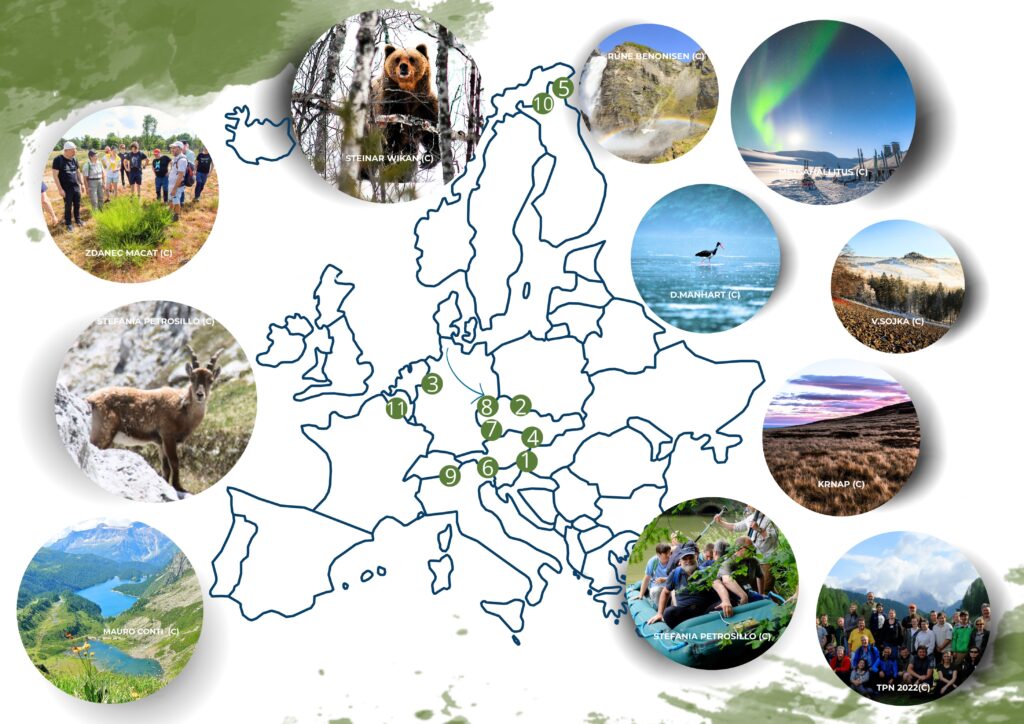TransParcNet Meeting 2018, David Freudl

Neusiedler See-Seewinkel & Fertö-Hanság, Austria – Hungary, since 2003
Straddling the border of Austria and Hungary, this transboundary park blends Alpine, Pannonian, and Mediterranean influences into a rich tapestry of life. The unique ecosystem around Lake Neusiedl brims with fascinating species, forming a critical refuge for wildlife.
Discover the secrets of this Austrian-Hungarian natural marvel here.

Krkonoše and Karkonosze National Parks, Czech Republic – Poland, since 2004
Home to unique arcto-alpine tundra, Krkonoše and Karkonosze National Parks were created in 1959 (Poland) and 1963 (Czechoslovakia). Despite Cold War-era border restrictions, meaningful cooperation began in 1990, leading to their EUROPARC certification as a joint transboundary park in 2004.
Explore how shared conservation has safeguarded this fragile mountain ecosystem here.

Maas-Schwalm-Nette Nature Park, Germany – Netherlands, since 2007
In this German-Dutch Nature Park, spanning 800 km², rivers, forests, and heathlands intertwine seamlessly. The park’s team works shoulder-to-shoulder daily to preserve this exceptional landscape, a testament to harmonious transboundary management.
Explore the wonders of Maas-Schwalm-Nette here.

Podyjí-Thayatal Transboundary Parks, Czech Republic – Austria, since 2007
Once divided by the Iron Curtain, the picturesque Dyje/Thayatal river valley now unites Moravia and Lower Austria. Once dotted with mills and summer retreats, the valley’s vibrant legacy was restored after decades of separation.
Step into the story of renewed Czech-Austrian collaboration here.

Pasvik-Inari Transboundary Area, Finland – Norway, since 2008
Founded in 2008, the Pasvik-Inari Transboundary Area is a shining example of transboundary cooperation, with roots reaching back to the early 1990s. After February 2022, the cooperation continued bilaterally as Pasvik-Inari Transboundary Area, and today it unites five protected areas across Finland and Norway, covering a total of 2666 km2.
Discover more about this unique collaboration that transcends borders here.

Julian Alps Transboundary Ecoregion, Italy – Slovenia, since 2009
A flourishing partnership between Italy’s Prealpi Giulie and Slovenia’s Triglav National Park began in 1996 and blossomed with EU support. By 2009, the dream of a unified transboundary ecoregion had become reality, inspiring conservation across this alpine paradise.
Learn more about the Italian-Slovenian partnership in the Julian Alps here.

Šumava and Bavarian Forest National Park, Czech Republic – Germany, since 2009
Covering over 922 km², Šumava and Bavarian Forest form Central Europe’s most expansive wilderness, where forests and wetlands thrive without human intervention. Guided by the philosophy “let nature be nature”, this partnership champions biodiversity and ecological restoration.
Discover the wonders of this unparalleled forest haven here.

Saxon-Bohemian Switzerland Transboundary Parks, Germany – Czech Republic, since 2012
The seeds of conservation were sown in the early 20th century, but it wasn’t until post-WWII that Saxon-Bohemian Switzerland truly united across borders. A fresh wave of cooperation followed the political changes of the 1990s.
Learn more about this historic German-Czech conservation effort here.

Binntal Veglia Devero Transboundary Nature Park, Switzerland – Italy, since 2019
In the rugged Lepontine Alps, Alpe Veglia and Alpe Devero (Italy) unite with Switzerland’s Landschaftspark Binntal to protect ancient glaciers, alpine pastures, and millennia-old traditions. Though official collaboration began in 2013, human connections here stretch back 3,000 years.
Unearth the geological and cultural treasures of the Alps here.

Háldi Transboundary Area, Finland – Norway, since 2021
The Háldi Transboundary Area links Finland’s Käsivarsi Wilderness with Norway’s Reisa National Park and Ráisduottarháldi Landscape. Formalised in 2020, this pristine Arctic realm offers profound natural and cultural significance.
Venture into the heart of the wild Háldi here.

European Nature Park of Scarpe Escaut Plains, France – Belgium, since 2022
Where the Scarpe and Escaut rivers flow, nature and history intertwine. This vibrant park, shared by France and Belgium, balances rural charm with urban pressures. It spans 62 municipalities and is home to over 290,000 people amid meadows, wetlands, and mining heritage.
Explore the crossroads of nature and history in Scarpe-Escaut here.

Currently suspended: Oulanka-Paanajärvi Transboundary Parks, Finland – Russia, since 2005
Since the early 1990s, Oulanka (Finland) and Paanajärvi (Russia) National Parks have nurtured a strong partnership. Their joint efforts gained momentum with the 2005 Interreg project: “Oulanka-Paanajärvi – Wilderness, Experiences, and Well-being”.
Read more about this Finnish-Russian cross-border collaboration here.
Each protected area featured here has successfully passed EUROPARC’s rigorous verification process, proving their unwavering dedication to collaboration, sustainability, and the protection of nature beyond borders. While many transboundary protected areas exist across Europe, only a select few have risen to meet this gold standard — setting the benchmark for conservation partnerships across the continent.
